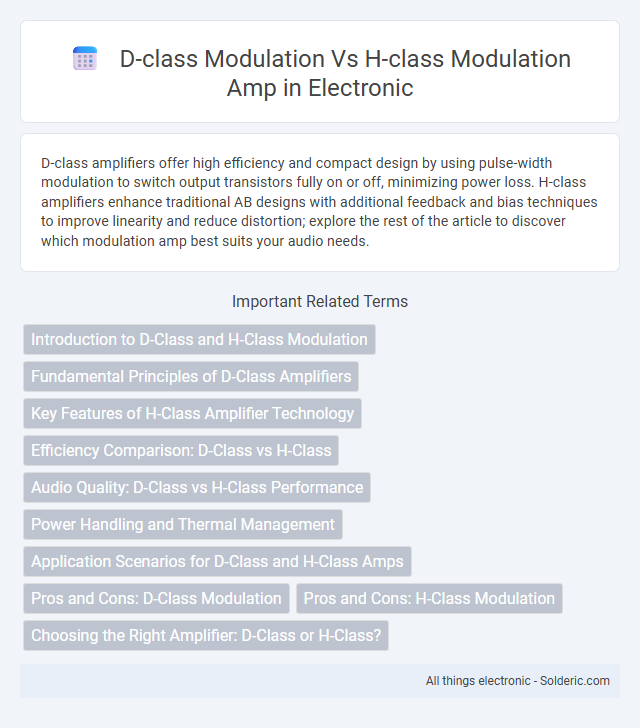D-class amplifiers offer high efficiency and compact design by using pulse-width modulation to switch output transistors fully on or off, minimizing power loss. H-class amplifiers enhance traditional AB designs with additional feedback and bias techniques to improve linearity and reduce distortion; explore the rest of the article to discover which modulation amp best suits your audio needs.
Comparison Table
| Feature | D-Class Amplifier | H-Class Amplifier |
|---|---|---|
| Modulation Type | Pulse Width Modulation (PWM) | Hybrid PWM with Dynamic Bias |
| Efficiency | Up to 90-95% | Up to 95-97% |
| Linearity | Moderate; requires filtering | Improved linearity over D-Class |
| Output Power | High power, suitable for portable and professional use | High power with better thermal management |
| Heat Dissipation | Low heat; efficient switching reduces losses | Lower heat than Class AB; optimized bias reduces losses |
| Complexity | Relatively simple digital PWM control | More complex control circuitry for bias management |
| Applications | Portable speakers, subwoofers, car audio | High-fidelity home audio, professional PA systems |
| Cost | Lower cost due to simpler design | Higher cost due to complex design and components |
Introduction to D-Class and H-Class Modulation
D-Class modulation amplifiers use pulse width modulation (PWM) to efficiently convert input signals into high-frequency square waves, achieving power efficiencies typically above 90%. H-Class modulation combines the principles of Class B linear amplification with high-efficiency switching, employing dynamic bias modulation to reduce crossover distortion and improve overall efficiency. Both technologies aim to optimize amplifier performance by balancing audio fidelity and power consumption, with D-Class excelling in compact, low-heat applications and H-Class providing superior sound quality in high-power scenarios.
Fundamental Principles of D-Class Amplifiers
D-class amplifiers operate by rapidly switching output devices between on and off states, using pulse-width modulation (PWM) to represent the input signal, which results in high efficiency and low heat dissipation. This digital switching approach contrasts with the linear operation of H-class amplifiers, enabling D-class amps to achieve efficiency levels often exceeding 90%. The fundamental principle of D-class modulation lies in its ability to convert analog signals into a series of rectangular pulses, which are then filtered to reconstruct the amplified audio waveform.
Key Features of H-Class Amplifier Technology
H-Class amplifier technology combines the efficiency of Class D modulation with linear amplifier benefits, using dynamic bias control to reduce power loss and heat generation. It features Adaptive Biasing that adjusts supply voltage according to the output signal, improving overall energy efficiency and sound fidelity compared to conventional Class D amplifiers. This results in high power density, reduced distortion, and enhanced audio performance in applications such as professional audio systems and high-end consumer electronics.
Efficiency Comparison: D-Class vs H-Class
D-Class amplifiers achieve efficiencies typically above 90% by using pulse-width modulation to switch output devices fully on or off, minimizing power loss as heat. H-Class amplifiers combine Class A/B operation with dynamic bias control, reaching around 70-80% efficiency by reducing crossover distortion without sacrificing linearity. Your choice depends on whether maximum energy savings or audio fidelity with moderate efficiency is the priority.
Audio Quality: D-Class vs H-Class Performance
D-Class amplifiers deliver high efficiency with minimal heat generation but can introduce higher distortion and noise, potentially affecting audio quality. H-Class amplifiers combine the efficiency of Class D with the audio fidelity of Class AB, achieving lower distortion and improved sound clarity. For critical listening environments, H-Class modulation generally provides superior audio performance compared to D-Class modulation.
Power Handling and Thermal Management
D-class amplifiers provide high power efficiency typically around 90%, allowing better power handling with minimal energy loss and reduced heat dissipation. H-class amplifiers combine the high efficiency of D-class with linearity improvements, achieving power handling comparable to D-class but with enhanced audio fidelity and slightly increased thermal output. Effective thermal management in D-class amps relies on compact heat sinks and switching techniques, while H-class designs often require more sophisticated cooling solutions to manage residual heat from the linear amplification stage.
Application Scenarios for D-Class and H-Class Amps
D-class amplifiers are ideal for battery-powered devices, portable audio systems, and automotive sound systems due to their high efficiency and low heat generation. H-class amplifiers excel in high-power audio applications such as professional sound reinforcement, large venue PA systems, and high-end home theater setups because they combine efficient energy use with enhanced audio fidelity. Both classes offer distinct advantages depending on the power requirements and thermal constraints of the application environment.
Pros and Cons: D-Class Modulation
D-Class modulation amps offer high efficiency, typically exceeding 90%, which reduces heat dissipation and allows for compact, lightweight designs ideal for portable or space-sensitive applications. However, they may introduce higher electromagnetic interference (EMI) and distortion compared to H-class amps, potentially affecting audio clarity in high-fidelity systems. Your choice depends on balancing power efficiency and sound quality, where D-Class excels in energy savings but may require additional filtering to meet stringent audio performance standards.
Pros and Cons: H-Class Modulation
H-Class modulation amplifiers combine the efficiency of Class D with the linearity of Class AB, offering improved audio fidelity and reduced distortion compared to pure Class D amps. They provide higher power efficiency and better heat management, making them suitable for high-performance audio systems where sound quality and energy savings are both critical. However, H-Class amps can be more complex and costly to manufacture, and their design may introduce slightly more signal processing latency than standard Class D models.
Choosing the Right Amplifier: D-Class or H-Class?
D-Class amplifiers operate with high efficiency by using pulse-width modulation, making them ideal for applications requiring lightweight and low heat dissipation. H-Class amplifiers combine Class A/B architecture with switching technology to offer improved sound quality alongside better efficiency than traditional amplifiers. Selecting between D-Class and H-Class depends on balancing efficiency, audio fidelity, and thermal management for specific audio system requirements.
D-class modulation vs H-class modulation amp Infographic

 solderic.com
solderic.com